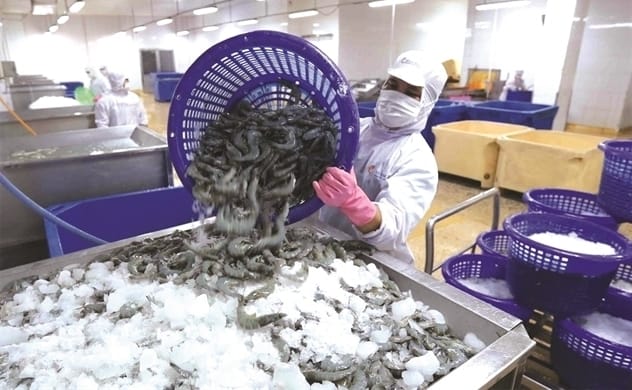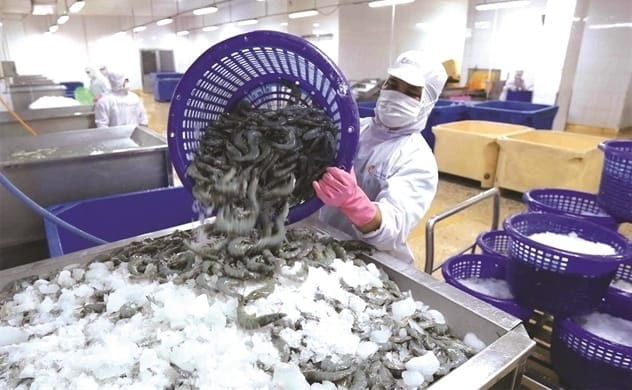
Minh Phu’s model is to buy shrimp from farmers at a guaranteed price so that farmers can make a profit, to avoid farmers leaving the supply chain. Photo: TTXVN.
Minh Phu Seafood Group JSC reported a loss of over VND26 billion in Q3 2023, despite returning to profit in the previous quarter. Net revenue fell 46% in the first nine months of 2023 reached VND7,465 billion. After deducting expenses, the company lost VND109.7 billion compared to a profit of VND571 billion in Q1 2023.
Barriers of the shrimp value chain
Minh Phu’s General Director, Mr. Le Van Quang, attributed the production difficulties to intense competition with shrimp from India and Ecuador. Ecuador’s production cost for 50-60 shrimp per kg is $2.3-2.4, while India’s is $3.4-3.8. Vietnam’s cost is $4.8-5.
China increased shrimp purchases from Ecuador, India, and Argentina in Q1 2023, while reducing orders from Vietnam. The country imported shrimp from Ecuador by 43%, India by 16%, and Argentina by 205% compared to last year. Minh Phu also received competitive offers from these markets, compared to domestic farmers’ 10% to over 14% buying prices.
Minh Phu reported losses in 2014, moving away from its golden age. Despite this, the company achieved a net profit of nearly VND800 billion, the highest in its history. The company aimed to become a billion-dollar enterprise and built a shrimp value chain, ranking first in Vietnam in shrimp export. The goal was to resolve technical and trade barriers with importing countries.
The firm’s shrimp value chain is struggling due to rapid market fluctuations and high costs. The company buys shrimp from farmers at a guaranteed price to avoid farmers leaving the supply chain.
However, the large supply and low prices from competitors have hindered price regulation, leading to business and debt issues. Large shrimp exporters like Sao Ta have shifted to importing cheap semi-finished shrimp for processing, reducing the risk of losses due to low raw shrimp prices.
Shifting strategic
Minh Phu’s leaders suggest that Vietnam’s shrimp farming industry must compete with Indian and Ecuadorian shrimp by utilizing its native species, collaborating with foreign partners to enhance seed quality, producing disease-resistant seeds, perfecting farming models, and raising disease-resistant shrimp at low density to reduce environmental impact.
Minh Phu aimed to avoid directly competing with Ecuador’s low prices by increasing the production and export of black tiger shrimp, white-leg shrimp, and land shrimp. His competitive strength was high-quality finished products, reducing costs by over 20%. However, Minh Phu’s leaders emphasized the need for shrimp farmers to self-reflect and innovate to improve and lower costs, as processing companies cannot afford to buy at high prices forever.
Vietnam’s shrimp export turnover decreased by 8% in September 2023 to $322 million, and by 26% in the first nine months of 2023 to $2.5 billion. The Vietnam Fisheries Association Chairman, Nguyen Viet Thang, predicts that shrimp production will continue to grow, reaching about 1 million tons of shrimp.
However, export turnover is expected to be difficult to achieve in 2022. Forecasts suggest that by the end of 2023, shrimp exports will reach $3 billion, a success compared to the initial target of $4.3 billion.
Minh Phu’s difficulties are common difficulties of Vietnam’s shrimp industry when facing a series of challenges in both input and output related to raw material supply from seed quality, disease control, and control of farming areas. , the proportion of area and output of shrimp raised according to GAP and organic certification standards…
Shrimp exporting enterprises like Minh Phu are aiming to expand into the Chinese market, the US, Australia, Korea, and Japan. Secretary General VASEP, Truong Dinh Hoe, suggests increasing organic, sustainable, value-added products, implementing appropriate sales and payment measures, and leveraging the advantages of the EVFTA Agreement to enhance competitiveness in new markets.



